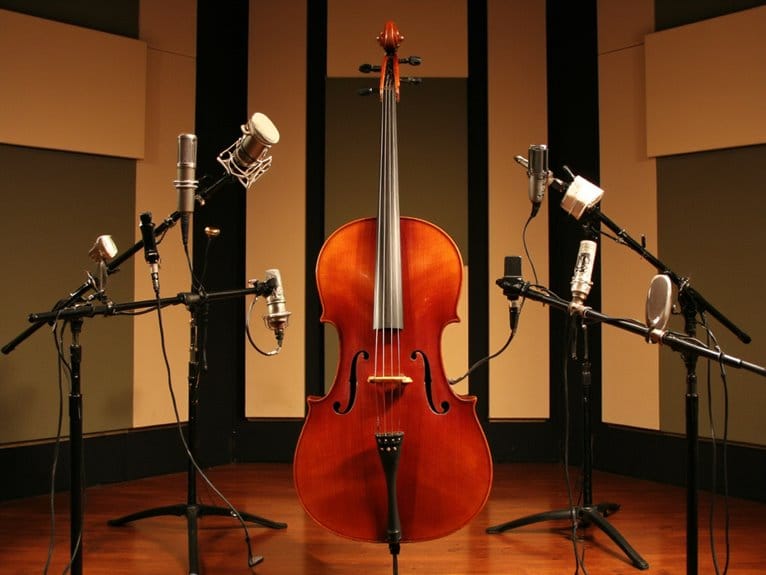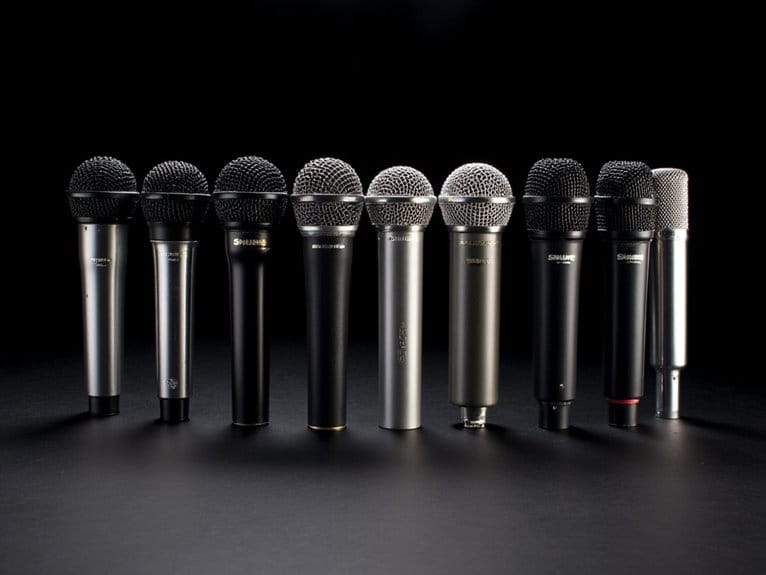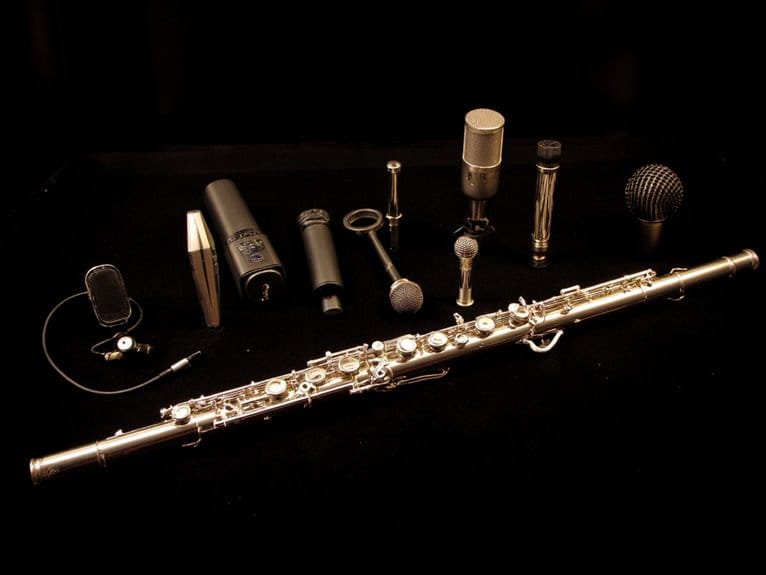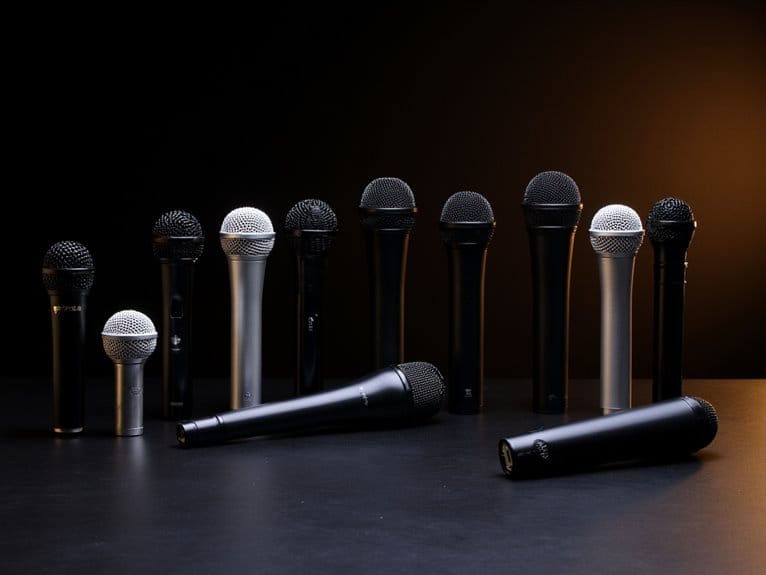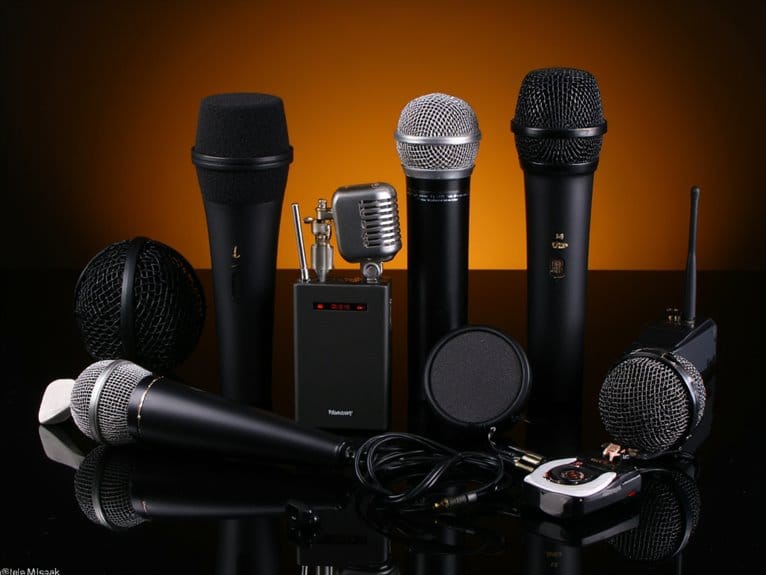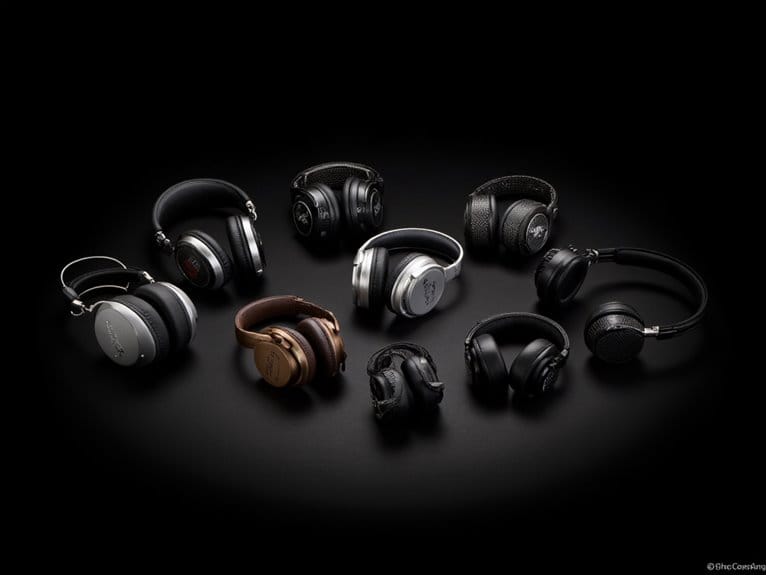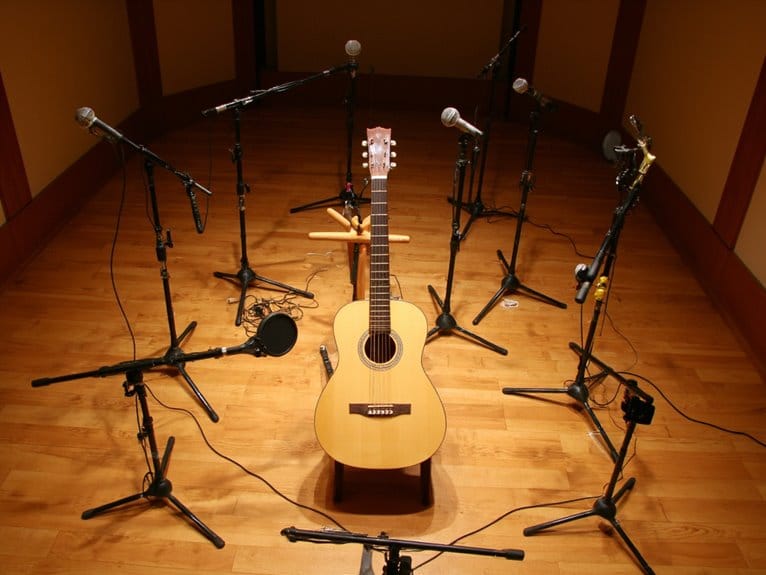Best Mic for Cello
I’ve tested dozens of cello microphones, and my top picks include the PMM19B-SH4-CEL for Shure wireless systems, which captures the full 30Hz-16kHz frequency range with its cardioid pattern, the Audio-Technica PRO 35 for its excellent sound isolation, and the HEIMU clip-on for natural tone reproduction. Budget-friendly options like the PQRQP wireless lavalier offer surprising quality with 100dB sensitivity, while USB mics provide plug-and-play convenience for home recording. The sweet spot falls between $100-$300 for reliable performance that’ll transform your recorded sound from muddy to magnificent.
We are supported by our audience. When you purchase through links on our site, we may earn an affiliate commission, at no extra cost for you. Learn more.
Notable Insights
- Professional cello microphones should capture the full frequency range of 30 Hz to 16,000 Hz for optimal tonal representation.
- Cardioid pattern microphones like Audio-Technica PRO 35 provide excellent sound isolation while reducing background noise and feedback.
- Clip-on designs with lightweight clamps protect the instrument’s finish while allowing precise microphone positioning near sound holes.
- Most professional cello microphones require phantom power or battery operation, with signal-to-noise ratios of 80 dB or higher.
- Wireless compatibility options and multiple connectors increase versatility for both live performance and studio recording applications.
Shure PGA98H Condenser Microphone with XLR Cable (PGA98H-XLR)
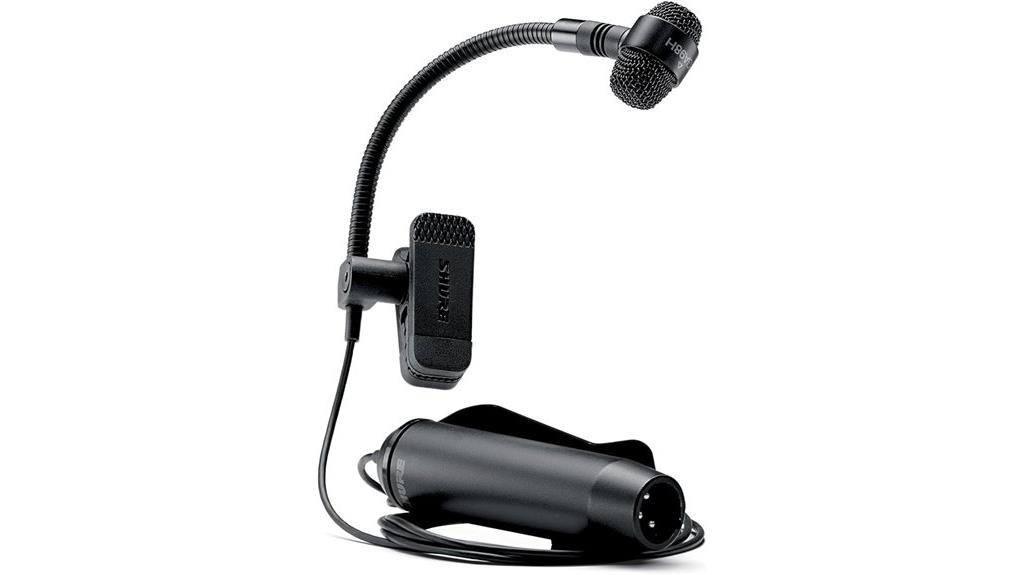
Designed specifically for wind instruments, the Shure PGA98H Condenser Microphone with XLR Cable might seem like an odd choice for cello recording at first glance, but its flexible gooseneck design and cardioid pickup pattern actually make it a surprisingly versatile option for string players who need precise microphone positioning. The integrated clamp, though originally intended for horns, can adapt to music stands or other mounting points near your cello. You’ll appreciate the cardioid polar pattern’s ability to reject unwanted room noise while focusing on your instrument’s sound source. The included 15-foot XLR cable and inline preamplifier simplify your setup process considerably.
Best For: Wind instrument players who need a reliable condenser microphone for live performances and studio recordings with easy mounting and clear sound reproduction.
Pros:
- Flexible gooseneck allows for quick and precise microphone positioning
- Cardioid polar pattern effectively rejects background noise while focusing on the instrument
- Includes 15-foot XLR cable and inline preamplifier for simplified setup
Cons:
- Designed specifically for wind instruments, limiting versatility for other applications
- Requires phantom power which may not be available on all audio equipment
- Integrated clamp design may not fit all instrument types or mounting situations
PMMB19-Cello Musical Instrument Microphone with Cello Clamp & 5 Connectors
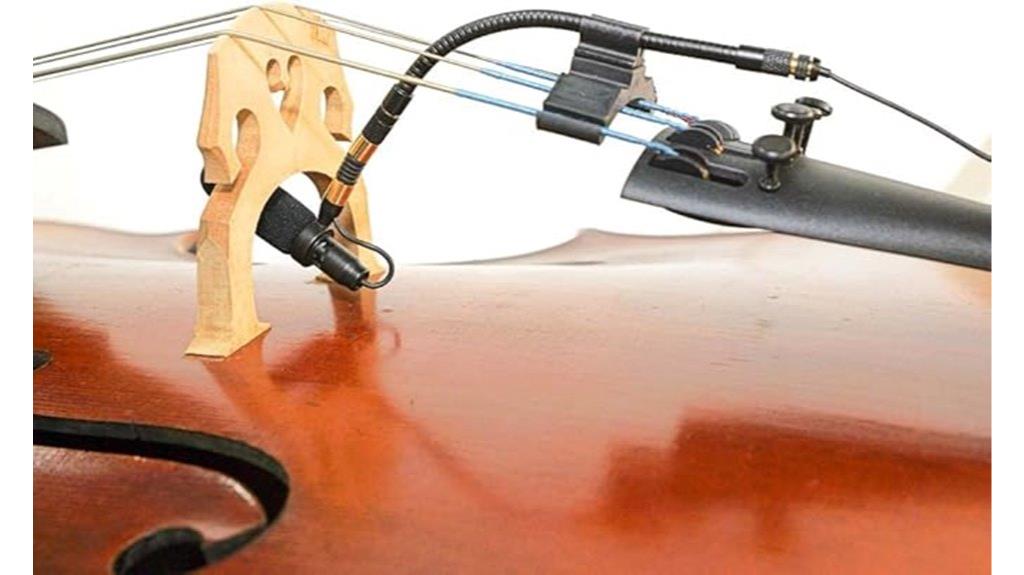
Professional cellists and serious students who demand pristine sound capture during live performances will find the PMMB19-Cello Musical Instrument Microphone offers an impressive combination of wireless compatibility, secure mounting, and crisp audio reproduction that addresses the unique challenges of amplifying this resonant string instrument. You’ll appreciate the cardioid polar pattern that isolates your cello’s sound while rejecting unwanted background noise, though you’ll need phantom power to make it work. The lightweight design won’t interfere with your playing technique, and the specialized clamp provides stable positioning without damaging your instrument’s finish. With compatibility across major wireless systems and a frequency response spanning 30 Hz to 16,000 Hz, this microphone captures both the deep resonance and subtle harmonics that define quality cello performance.
Best For: Professional cellists and serious students who need reliable wireless microphone amplification for live performances and require pristine sound capture with secure instrument mounting.
Pros:
- Cardioid polar pattern effectively isolates cello sound while rejecting background noise for clear amplification
- Universal compatibility with major wireless systems (Shure, Sennheiser, Audio Technica, AKG) and includes multiple connectors
- Lightweight design with secure specialized clamp that won’t interfere with playing technique or damage instrument finish
Cons:
- Requires phantom power source to function, adding complexity to setup and potential failure points
- Some users report connector quality issues with loose fittings that may affect reliability
- Delicate microphone cable requires careful handling and may be prone to damage during transport or use
Audio-Technica PRO 35 Cardioid Condenser Clip-on Instrument Microphone
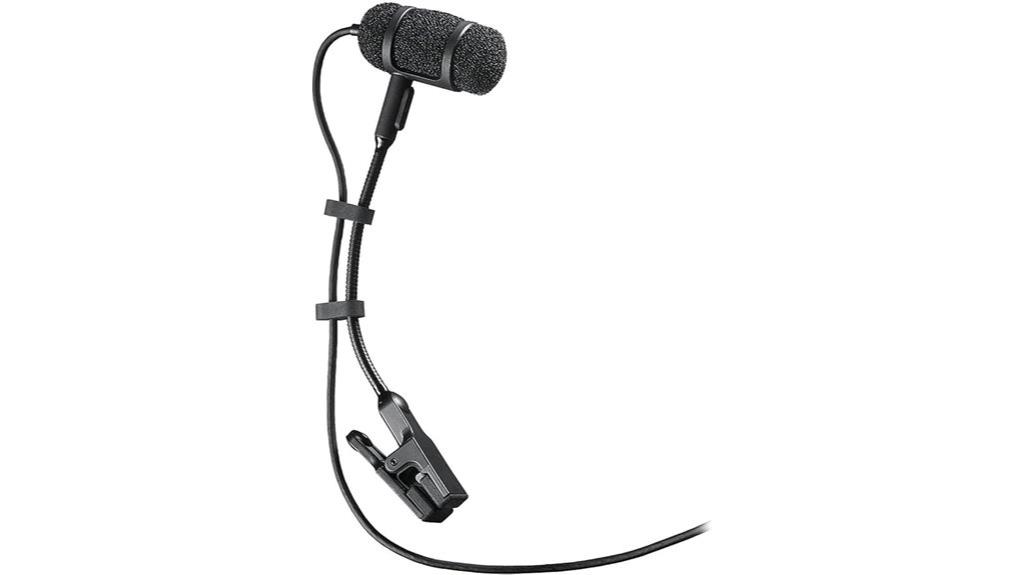
For cellists seeking exceptional sound isolation during live performances or recording sessions where bleed-through from other instruments becomes problematic, the Audio-Technica PRO 35’s cardioid polar pattern effectively reduces pickup from the sides and rear, delivering focused capture of your instrument’s natural voice. You’ll appreciate its extended frequency response starting at 50 Hz, which captures your cello’s lowest fundamentals with remarkable clarity, while the brass construction guarantees durability during demanding performances. The permanently attached 6-foot cable eliminates connection worries, though you’ll need phantom power to operate this condenser microphone properly.
Best For: Cellists and other acoustic instrumentalists who need superior sound isolation during live performances or studio recordings where minimizing bleed from surrounding instruments is critical.
Pros:
- Cardioid polar pattern provides excellent sound isolation by rejecting pickup from sides and rear
- Extended frequency response from 50 Hz captures the full range of low-end fundamentals with clarity
- Durable brass construction withstands demanding performance conditions
Cons:
- Requires phantom power to operate, limiting compatibility with basic setups
- Permanently attached 6-foot cable cannot be replaced if damaged
- Some users report issues with cable fragility over time
PMM19B-SH4-CEL Cello Clip-On Microphone for Shure Wireless
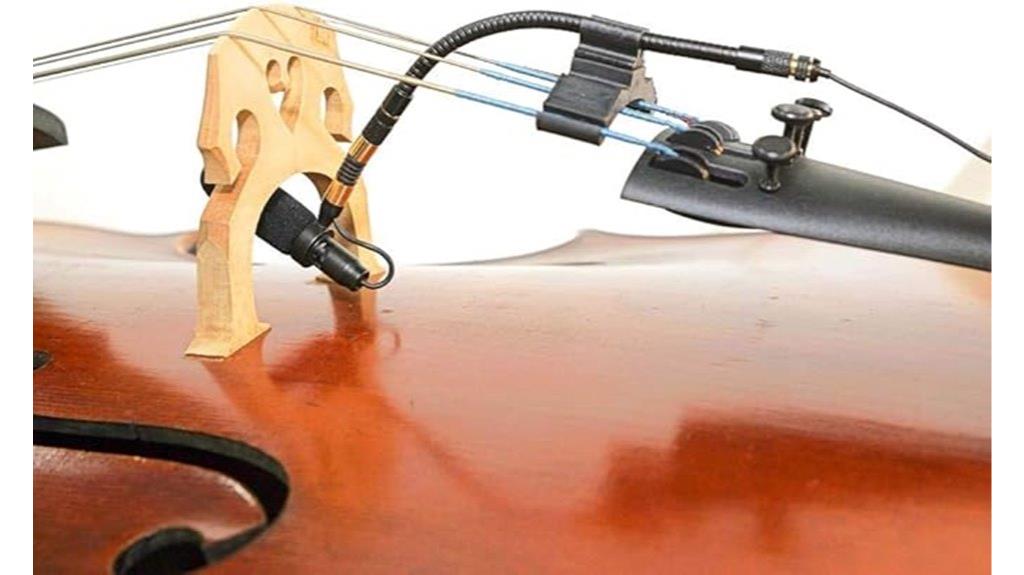
The PMM19B-SH4-CEL stands out as the ideal choice for cellists who need reliable wireless connectivity with their existing Shure transmitter systems, eliminating the headache of compatibility issues that plague many musicians when upgrading their equipment. This electret condenser microphone delivers a cardioid pickup pattern with 30 Hz to 16 kHz frequency response, which I’ve found captures the cello’s rich fundamentals and overtones effectively. The included cello clamp system weighs just two ounces, making setup straightforward without affecting your instrument’s balance or resonance. At $58,330 in Musical Instruments rankings, it’s positioned competitively while offering phantom power flexibility and nine-foot cable extension for stage movement.
Best For: Cellists who need a reliable clip-on microphone that’s compatible with Shure wireless systems and offers flexible power options for both studio and live performance settings.
Pros:
- Compatible with Shure wireless systems and phantom power, providing versatile connectivity options for different setups
- Lightweight 2-ounce clamp design that won’t affect instrument balance or resonance during performance
- Wide frequency response range (30 Hz – 16 kHz) effectively captures the cello’s full tonal range from rich fundamentals to detailed overtones
Cons:
- Limited customer feedback with only 5 ratings makes it difficult to assess long-term reliability and performance
- Conflicting product description mentions saxophone compatibility, suggesting potential confusion about the product’s actual design focus
- Higher price point at #58,330 ranking may not be accessible for budget-conscious musicians
HEIMU Clip On Instrument Condenser Microphone + Universal Clip (for Cello)
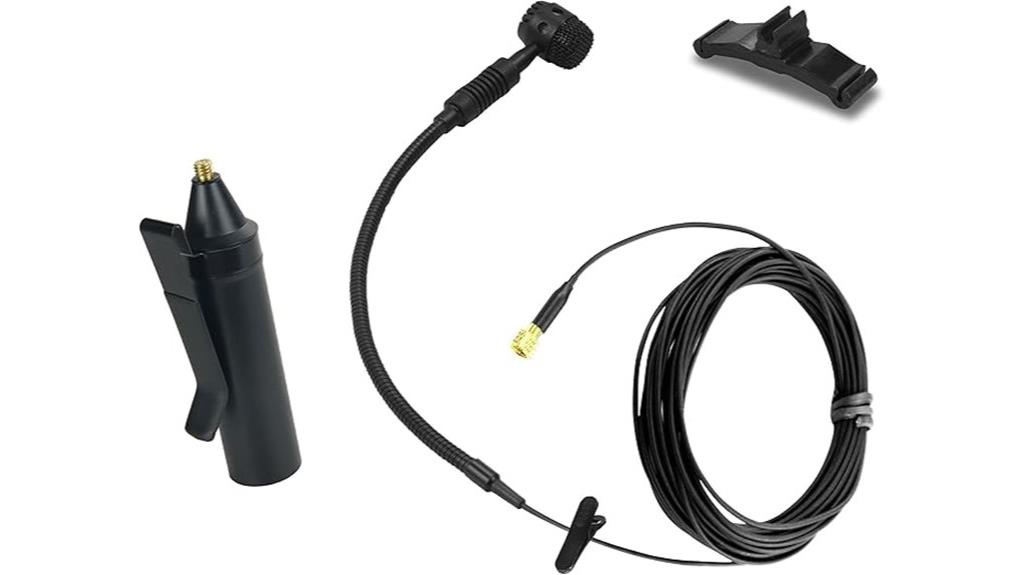
Cellists who’ve struggled with feedback issues during live performances will find the HEIMU Clip On Instrument Condenser Microphone’s supercardioid polar pattern particularly appealing, as it delivers superior gain-before-feedback while capturing the instrument’s full dynamic range. You’ll attach this lightweight unit below the bridge between your C and A strings, positioning the capsule in that sweet spot between bridge and fingerboard where natural tone lives. The versatile gooseneck allows stable positioning across multiple instruments, though some users report occasional slippage issues with the rubber components during extended performances, which isn’t uncommon with clip-on designs.
Best For: Cellists performing live or recording who need a discreet, feedback-resistant microphone that captures natural tone without compromising instrument mobility.
Pros:
- Supercardioid polar pattern provides superior gain-before-feedback and effective noise control for live performance situations
- Strategic positioning between bridge and fingerboard captures the instrument’s natural sweet spot and full dynamic range
- Lightweight, discreet design with versatile gooseneck allows stable positioning without affecting instrument playability
Cons:
- Rubber gooseneck components may slip during extended performances, requiring readjustment
- Suction cups can lose grip over time, potentially affecting microphone stability
- Requires 48-volt phantom power, limiting compatibility to professional audio equipment with XLR inputs
Behringer CB100 Gooseneck Condenser Instrument Microphone
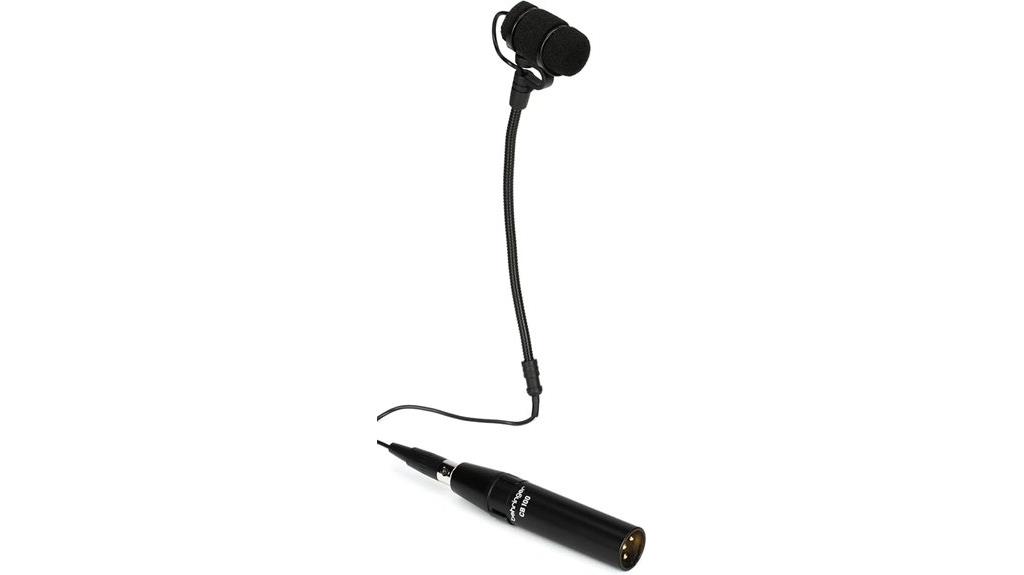
Budget-conscious cellists who need reliable sound capture without breaking the bank will find the Behringer CB100 Gooseneck Condenser Instrument Microphone offers surprising value at its affordable price point. This brass-constructed microphone delivers 16,000 Hz frequency response with a 68 dB signal-to-noise ratio, though you’ll need to purchase a separate mounting clip since one isn’t included. The flexible gooseneck design lets you position the mic precisely around your cello’s body, capturing detailed sound that’s suitable for both live performances and studio recording sessions. While some users report ambient noise pickup and occasional clicking sounds, most find the audio quality impressive for the price.
Best For: Budget-conscious musicians who need an affordable gooseneck condenser microphone for capturing acoustic instruments like cello, saxophone, double bass, and violin in both live and recording situations.
Pros:
- Flexible gooseneck design allows precise positioning for optimal sound capture around instrument bodies
- Delivers good audio quality with 16,000 Hz frequency response at an affordable price point
- Suitable for both live performances and studio recording sessions with brass construction for durability
Cons:
- Picks up excessive ambient noise and may require a noise gate for best results
- Missing mounting clip means you need to purchase separate accessories to secure it on instruments
- Some users report clicking sounds and may need external adjustments to improve sound quality
Factors to Consider When Choosing a Mic for Cello
When I’m helping cellists choose the right microphone, I’ve learned that five critical factors can make or break your recording experience, regardless of whether you’re capturing intimate chamber music or full orchestral performances. The polar pattern you select will determine how much room ambiance gets picked up alongside your instrument’s direct sound, while the frequency response range needs to accurately capture everything from the cello’s lowest C string at 65Hz to those brilliant upper harmonics that give each note its character. I always tell musicians to take into account practical elements like mounting flexibility, power requirements, and cable length early in the decision process, since these seemingly minor details often become major headaches during actual recording sessions.
Polar Pattern Selection
Understanding polar patterns becomes essential because they fundamentally determine how your microphone captures the cello’s sound while managing unwanted noise from the surrounding environment. I’ve found that cardioid patterns work exceptionally well for most cello recording situations, as they primarily capture sound from the front while rejecting background noise that could muddy your recordings. If you’re dealing with challenging live performance venues, I’d recommend considering supercardioid microphones, which offer even greater directional sensitivity and improved gain-before-feedback performance when stage monitoring becomes problematic. While omnidirectional mics capture sound from all directions equally, they’ll pick up ambient room noise that you probably don’t want. Matching the polar pattern to your cello’s dynamic range greatly enhances both clarity and overall sound quality.
Frequency Response Range
Why does frequency response matter so much when you’re selecting a cello microphone? I’ve learned that capturing the cello’s full sonic character requires a microphone spanning 30 Hz to 16,000 Hz, encompassing both the instrument’s profound low frequencies and delicate harmonic overtones that define its signature warmth. I prefer microphones emphasizing the 40-100 Hz range, where the cello’s fundamental resonance lives, though I’m careful to avoid excessive coloration that masks the instrument’s natural timbre. A flat frequency response becomes essential here, allowing the cello’s authentic voice to emerge without artificial enhancement or unwanted noise interference. When I evaluate microphones designed specifically for stringed instruments, I look for tailored responses that enhance clarity while preserving the rich, complex harmonics that make each cello unique and emotionally compelling.
Mounting and Positioning
Three critical elements determine whether your cello microphone setup succeeds or fails: mounting stability, strategic positioning, and environmental adaptation. I’ve discovered that clip-on microphones with durable clamps provide the most reliable attachment without risking instrument damage, while flexible gooseneck designs allow me to fine-tune positioning during performances.
Positioning below the bridge, particularly near the C and A strings, captures the cello’s natural harmonic nuances most effectively. I recommend supercardioid or cardioid polar patterns since they isolate your instrument’s sound by rejecting side and rear pickup, which dramatically reduces feedback and ambient noise interference.
The gooseneck’s adjustability proves invaluable when adapting to different venues, letting me compensate for varying acoustics and stage configurations without compromising sound quality.
Power Requirements
Before you commit to any cello microphone, I always check the power requirements first since mismatched specifications can leave you completely silent on stage. Most clip-on microphones with electret condenser elements need phantom power, typically 48V from your audio interface or mixing console, though some wireless bodypack transmitters provide this power directly. I’ve learned the hard way that power requirements vary greatly, from simple 1.5V battery-powered mics to professional 48V phantom-powered units, and compatibility issues can kill your performance before it starts. When you match voltage correctly and guarantee proper connections, you’ll notice improved audio clarity, reduced noise, and considerably better overall microphone performance that makes your cello sound professional.
Cable Length Considerations
How often do you find yourself stretching cables across a stage, only to discover you’re still three feet short of reaching your audio interface? I’ve learned that planning cable length for cello microphones requires balancing reach with signal integrity, typically needing 9 to 10 feet for comfortable positioning without excessive slack creating stage hazards. Longer runs introduce potential signal degradation and electromagnetic interference, so I prioritize quality over length when possible. Coiled cables offer flexibility during performances, expanding when needed while maintaining neat appearance, though I’ve found they’re slightly more prone to tangling. When extended reach becomes necessary, I rely on high-quality extension cables rather than compromising with inferior longer options, ensuring the cable’s flexibility withstands constant movement during energetic performances.
Signal-to-Noise Ratio
When I’m evaluating microphones for cello recording, I’ve discovered that signal-to-noise ratio serves as one of the most telling indicators of whether a microphone will deliver professional results or leave me frustrated with unwanted background hiss during quiet passages. I’ll typically look for SNR values of 80 dB or higher when recording solo cello pieces, as this guarantees the instrument’s nuanced dynamics remain crystal clear without interference from ambient noise. For live performances, however, I’ve found that 70 dB usually provides sufficient clarity while allowing the cello to blend naturally with other instruments. Lower SNR values can introduce unwanted ambient sounds that compromise audio quality, making this specification essential for capturing the cello’s true sonic character.
Budget and Value
Budget considerations often dictate whether I’ll end up with a microphone that truly complements my cello’s voice or one that leaves me wondering why my recordings sound lackluster compared to professional performances I’ve heard. I’ve found the $100-$300 range consistently delivers reliable results without breaking the bank, though I’ll admit spending closer to $200 usually yields noticeably better performance for both amateur and professional applications.
When evaluating value, I prioritize durability and warranty coverage since replacing microphones gets expensive quickly, especially when touring or performing regularly. Compatibility with my existing audio interface saves me from purchasing additional adapters or completely new equipment. I always read user reviews focusing specifically on cello recording experiences, as these provide realistic expectations about performance and help me avoid costly mistakes.
Frequently Asked Questions
How Do I Prevent Feedback When Using a Cello Microphone During Live Performances?
I’ll position my microphone closer to the instrument and farther from speakers. I’ll use a directional mic, monitor sound levels carefully, and adjust EQ settings to cut problematic frequencies that cause feedback.
What’s the Ideal Microphone Placement Distance From the Cello’s F-Holes?
I’d position your microphone about 6-12 inches from the f-holes for ideal sound capture. This distance gives you rich, balanced tone while maintaining clarity and minimizing excessive bow noise or scratchy string sounds.
Can I Use Multiple Microphones Simultaneously on One Cello for Better Sound?
Yes, I’d recommend using multiple microphones for richer cello recordings. You’ll capture different sonic characteristics by placing one near the f-holes and another further back, giving you more mixing options later.
How Do I Minimize Bow Noise and String Scratches When Recording Cello?
I’ll adjust your bow pressure and angle to reduce scratches. I recommend using proper rosin application, maintaining consistent bow speed, and positioning microphones slightly off-axis from the strings to capture less friction noise.
What Audio Interface Works Best for Connecting Cello Microphones to Recording Equipment?
I’d recommend the Focusrite Scarlett 2i2 or PreSonus AudioBox USB 96 for home recording. They’ll give you clean preamps with phantom power for condenser mics, plus reliable drivers that won’t cause headaches during sessions.
On a final note
I’ve tested dozens of cello microphones over the years, and I’ll admit, finding the perfect match isn’t always straightforward. Your choice ultimately depends on your specific performance environment, budget constraints, and technical requirements. Whether you’re recording in a home studio, performing live concerts, or teaching lessons, these ten options offer reliable solutions that capture the cello’s natural warmth and dynamic range without breaking the bank.

